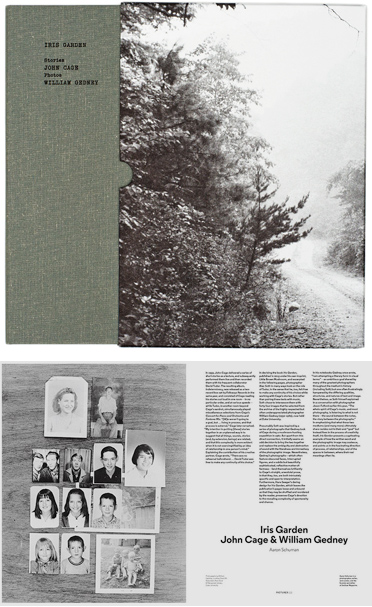
Iris Garden: John Cage & William Gedney (Little Brown Mushroom, 2014)
by Aaron Schuman
Winter 2014
This essay was originally published in Aperture, Winter 2014.
In 1959, John Cage delivered a series of short stories as a lecture, and subsequently performed them live and then recorded them with his frequent collaborator David Tudor. The resulting album, Indeterminacy, was released as a two-record box set by Folkways Records in the same year, and consisted of Cage reading his stories out loud in one room—in no particular order, and at various speeds—while Tudor, in another room beyond Cage’s earshot, simultaneously played miscellaneous selections from Cage’s Concert for Piano and Orchestra and Fontana Mix. “[W]e weren’t going to a goal, but . . . living in process, and that process is external,” Cage later remarked. “My intention in putting [these] stories together in an unplanned way is to suggest that all things, sounds, stories (and, by extension, beings) are related, and that this complexity is more evident when it is not over-simplified by an idea of relationship in one person’s mind.” Explaining the contribution of his creative partner, Cage wrote, “There was no rehearsal beforehand . . . David Tudor was free to make any continuity of his choice.”
In devising the book Iris Garden, published in 2013 under his own imprint, Little Brown Mushroom, and excerpted in the following pages, photographer Alec Soth in many ways took on the role of Tudor, in the sense that he too felt free to make any continuity of his choice while working with Cage’s stories. But rather than pairing these texts with music, Soth chose to interweave them with forty-four images that he selected from the archive of the highly respected but often underappreciated photographer, William Gedney (1932–1989), now held at Duke University.
Presumably Soth was inspired by a series of photographs that Gedney took of Cage during a mushroom-hunting expedition in 1967. but apart from this direct connection, it initially seems an odd decision to bring the two together, and replace the ambiguity and abstraction of sound with the literalness and immediacy of the photographic image. Nevertheless, Gedney’s photographs—which often feature obscured faces, interrupted figures, and a subtle but beautifully sophisticated, reflective matter-of-factness—lend themselves brilliantly to Cage’s straight, anecdotal prose, in that they too are both intricately specific and open to interpretation. Furthermore, Hans Seeger’s daring design for Iris Garden, which leaves the publication’s pages loose and unbound so that they may be shuffled and reordered by the reader, preserves Cage’s devotion to the revealing complexity of spontaneity and chance.
In his notebooks Gedney once wrote, “I am attempting a literary form in visual terms”—an ambitious goal shared by many of the greatest photographers throughout the medium’s history (including Soth), but one often frustratingly hampered by the differing qualities, structures, and natures of text and image. Nevertheless, as Soth himself explained in a conversation with photographer Jason Fulford earlier this year, “The whole spirit of Cage’s music, and most photography, is listening to what is not there—the sound between the notes, the story between the photographs.” In emphasizing that what these two mediums (and many more) ultimately share resides not in their end “goal”, but instead lives in the process of creativity itself. Iris Garden presents a captivating example of how the written word and the photographic image may coalesce, and points us in the fascinating direction of process, of relationships, and of the spaces in between, where their real meanings often lie.
Aaron
Schuman Photography
Copyright © Aaron Schuman, 2014. All
Rights Reserved.
This site and all of its contents may not be reproduced, in whole or in
part, in any form, without the written permission
of Aaron Schuman, and other additional artists involved in the production
of specific works exhibited on this site.